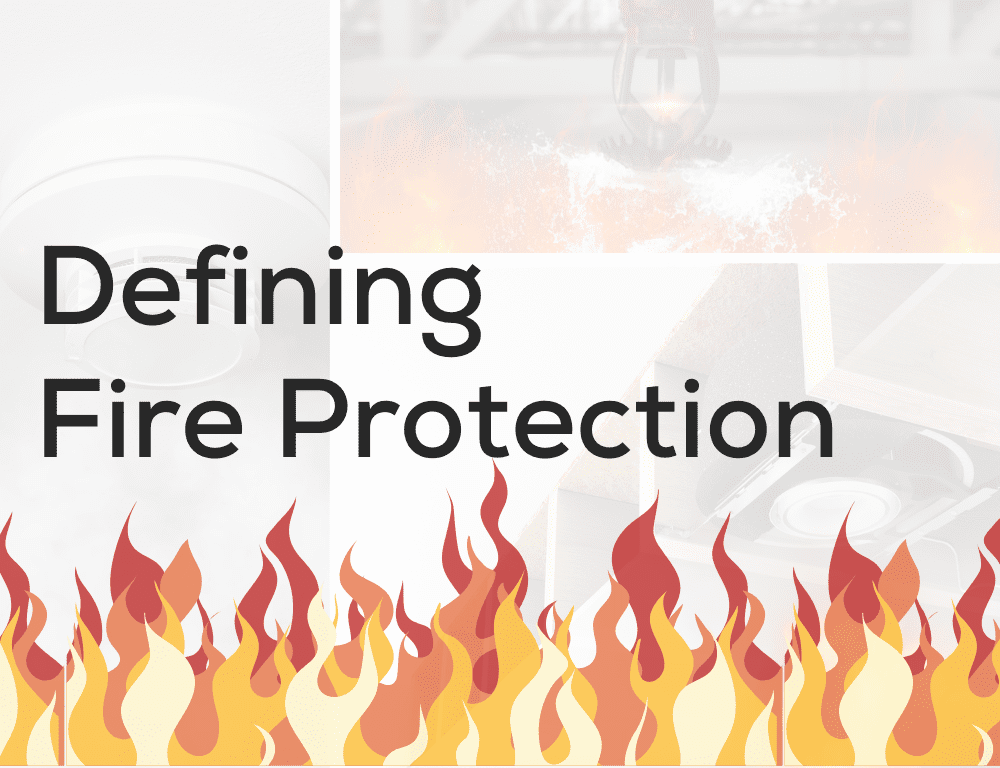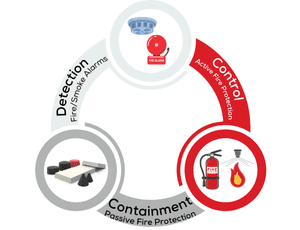Discover how the pillars of Detection, Control and Containment work cohesively to protect the lives and properties in our communities.
What is Fire Protection?
Did you know that the practice of fire protection is more than just specifying a sprinkler system or installing smoke detectors throughout a facility? Defined by the National Fire Protection Association (NFPA), fire protection is defined as “methods of providing for fire control or fire extinguishment”. As previously stated, there are a variety of moving parts in the definition of fire protection; therefore, it is critical to fully comprehend all of the pieces to the puzzle of fire protection. Fire protection is composed of three different segments: Detection, Control, and Containment. Each of these segments are important independently; however, the cohesion of all three segments are essential when creating an optimal fire protection system. Furthermore, let’s explore deeper on the significance of each pillar’s role in a fire protection system and how they work interconnectedly to protect the lives and properties within our communities.
defined as “methods of providing for fire control or fire extinguishment”. As previously stated, there are a variety of moving parts in the definition of fire protection; therefore, it is critical to fully comprehend all of the pieces to the puzzle of fire protection. Fire protection is composed of three different segments: Detection, Control, and Containment. Each of these segments are important independently; however, the cohesion of all three segments are essential when creating an optimal fire protection system. Furthermore, let’s explore deeper on the significance of each pillar’s role in a fire protection system and how they work interconnectedly to protect the lives and properties within our communities.
Detect and Alert: The Pillar of Detection
In a general sense, most individuals are familiar with the installation of smoke detectors, whether it is in a residential or commercial setting. However, are you familiar with the staggering benefit of implementing a smoke detector? Since being introduced in the 1960s, smoke detectors have dropped home fire deaths by nearly 50%. Now, while smoke detectors play a key role in the pillar of Detection, there is a greater depth to this pillar. The pillar of Detection is the first moving part in a fire protection system, due to its ability to alert occupants of the initial stages of an active fire. Whether the source of the alert is through a smoke detector or a fire alert system, these technologies allow for a lengthen 
Key Functions Include:
- Swift Evacuation: Early warnings facilitate prompt evacuation, significantly reducing the risk of injury or death.
- Minimize Property Damage: Detecting fires early helps prevent them from spreading, nearly diminishing the chances of property damage.
- Continuous Monitoring: Fire and smoke detectors provide 24/7 surveillance, crucial in places where fires could occur during non-operational hours.
Because of its key functions, the pillar of Detection plays a pivotal role in a fire protection system; however, it is not the only vital piece in a fire protection system.
Taming the Flames: The Pillar of Control
Early stages of fire protection, such as the pillar of detection, play a vital role in keeping our communities safe; however, how does fire protection play a role in controlling the fire outbreak itself? One of the most widely recognized forms of fire protection are found within the pillar of Control, fire sprinkler systems and fire extinguishers. Fire sprinklers and fire extinguishers are a key component in controlling the fire itself – no matter if you are dealing with a small cooking fire or a large electrical-based fire. Often, these systems are activated by heat, smoke, or flame, permitting them to be activated during the early stages of a fire outbreak. As a result, this technology is able to produce a ~96% effectiveness rate in fire control. With the implementation of these systems, it allows for a wide range of benefits which include:
Main Benefits Include:
- Reaction Time: For individuals who need an extended evacuation period, these systems are able to extinguish the fire in a matter of minutes – allowing for a prolonged evacuation period.
- Scale of Fire: No matter how small or big the fire is, these systems will be able to diminish the fire in a timely manner.
- Reduced Smoke Inhalation: By controlling the fire early, these installations can minimize the production of smoke and toxic gases, which are often more than dangerous than the flame themselves.
Even though this element of fire protection is universally acknowledged, it is crucial to ensure these systems are updated in current structures and implemented correctly into new construction projects, regardless of if the buildings are commercial or residential. If these systems are not properly maintained, there will be a breach of life safety in that particular community.
The Hidden Guardian of Life Safety: The Pillar of Containment.
So far, we have discussed the detection and controlling of a fire outbreak. But let’s paint a scenario. What if occupants ignore a smoke detector alarm because it randomly goes off throughout the day, or what if there is a malfunction in a fire sprinkler system? How do we protect the lives and properties in these cases? Here we introduce the hidden component, the pillar of Containment. Within the pillar of Containment, the practice of passive fire protection was developed with the purpose of slowing and preventing the spread of fire within a building through the use of fire rated materials. Often, we see a rapid acceleration in the spread of fire when given the accessibility to unprotected building openings, ranging from holes caused by recessed light fixtures, openings in cable trays, exterior cavities, and so much more. In order to compartmentalize the spread of flames and smoke, specifying properly fire tested and certified solutions in these openings greatly diminishes the development of a fire outbreak. With the specification of passive fire protection, its
Core Strengths Include:
- Back-Up Plan: In the event where a sprinkler system or a smoke detector fails, passive fire protection steps in to contain the fire outbreak.
- No Additional Steps: When a fire is activated, these devices are automatically deployed by the rise in temperature, allowing for openings to be sealed off before smoke and fire can travel elsewhere.
- Extension for First Responders: With the fire properly contained, first responders have an extended response time – permitting a greater loss in lives and property.
Regardless of its strong benefits, the pillar of Containment tends to be the lesser-known form of fire protection. One of the primary reasons is that its solutions are integrated during renovation and new construction projects, often hidden within the building’s ceiling, wall and floor assemblies. Nonetheless, the pillar of Containment plays an equally critical role in a fire protection system, such as the pillars of Detection and Control – even though, it tends to function primarily in the background.
Completing the Full Circle of Fire Protection.
Detection. Control. Containment. With the presence of each of these pillars, our communities will be properly safeguarded from the tragic effects of a fire outbreak. To achieve this level of protection, it is critical that each component is properly integrated into both current and future construction developments. By doing so, we establish a proper framework that not only prevents fire outbreaks but also minimizes their potential damage, creating a safer community.
If you are interested in learning more about passive fire protection’s role in the pillar of Containment, schedule a free 1-1 training session with Tenmat’s Mirka Carlson. To schedule your session, please click here.
Sources
Benefits of installing a fire and Smoke Detector System. Kimble & Company. (2024, September 5). https://www.kimblefire.com/benefits-of-installing-a-fire-and-smoke-detectorsystem/#:~:text=Fire%20and%20smoke%20detection%20systems%20are%20vital%20for,essential%20for%20saving%20lives%20and%20reducing%20property%20damage.
Fire containment. International Firestop Council. (2024, August 23). https://firestop.org/fire-containment/
Fire, I. (2024, August 7). Active vs. Passive Fire Protection Systems. Impact Fire Services, LLC. https://resources.impactfireservices.com/active-vs.-passive-fire-protection-systems-the-basics-you-need-to-know
Gollner, M. J. (2016, June 23). Detection and suppression of fires: A cornerstone of Fire Protection Engineering – Fire Technology. SpringerLink. https://link.springer.com/article/10.1007/s10694-016-0606-2
NFPA glossary of terms (2021) free PDF download. nfpa.org. (2021). https://www.nfpa.org/downloadable-resources/definitions/nfpa-glossary-of-terms-2021
What is passive fire protection?. Fire Protection Association. (2023, June 30). https://www.thefpa.co.uk/advice-and-guidance/advice-and-guidance-articles/what-is-passive-fire-protection-
Wood, L. (2020, December 2). Basic fundamentals of fire protection. Safenetix. https://www.safenetix.com/2020/12/01/fire-protection-fundamentals/








